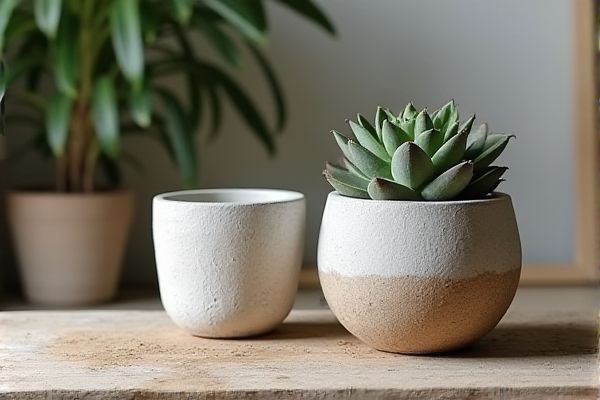
Hypertufa pots offer a lightweight, porous alternative to traditional concrete pots, promoting better aeration and drainage for your plants, while concrete pots provide superior durability and strength, ideal for long-term outdoor use. Explore the detailed comparison in this article to choose the perfect potting solution for your gardening needs.
Table of Comparison
| Feature | Hypertufa Pots | Concrete Pots |
|---|---|---|
| Material Composition | Mix of peat moss, perlite, and cement | Portland cement, sand, and gravel |
| Weight | Lightweight | Heavy |
| Porosity | Highly porous for good drainage | Low to moderate porosity |
| Durability | Moderately durable, susceptible to cracking over time | Very durable, resistant to weathering |
| Appearance | Natural, rustic look | Smooth or rough texture, customizable finishes |
| Cost | Generally lower cost | Higher cost due to materials and weight |
| Ideal Use | Best for lightweight, decorative garden pots | Suitable for heavy-duty, large planters |
Introduction to Hypertufa and Concrete Pots
Hypertufa pots consist of a lightweight mixture of peat moss, perlite, and cement, designed to mimic natural tufa rock, making them ideal for garden containers with excellent drainage and insulation. Concrete pots are made from solid cement and aggregates, offering durability and strength but tend to be heavier and less porous than hypertufa. Both options provide unique benefits for plant health, with hypertufa promoting better aeration and concrete ensuring long-lasting structural support.
Composition and Materials Used
Hypertufa pots are composed primarily of a lightweight mixture of peat moss, perlite, and Portland cement, offering excellent drainage and aeration for plant roots. Concrete pots consist mainly of Portland cement, sand, and water, resulting in a denser and heavier structure that provides durability and heat retention. The inclusion of organic materials in hypertufa creates a more porous texture compared to the solid, compact form of traditional concrete pots.
Weight Comparison: Hypertufa vs Concrete
Hypertufa pots weigh significantly less than traditional concrete pots due to their mixture of peat moss, perlite, and cement, resulting in a lightweight yet durable material ideal for easy handling and mobility. Concrete pots, composed entirely of cement and aggregate, tend to be much heavier, offering greater stability but less portability. The reduced weight of hypertufa pots makes them particularly advantageous for rooftop gardens and balcony containers where structural load is a concern.
Durability and Longevity
Hypertufa pots offer lightweight durability with good resistance to weathering but typically last around 5 to 10 years before showing signs of wear, while concrete pots boast superior longevity, often exceeding several decades due to their dense, robust structure. Concrete's higher compressive strength and lower porosity make it less prone to cracking and deterioration from freeze-thaw cycles compared to hypertufa, which is more porous and susceptible to surface erosion. For long-term outdoor use, concrete pots provide enhanced structural integrity and lasting performance, making them a preferred option for durability and longevity.
Aesthetic Appeal and Customization
Hypertufa pots offer a natural, rustic aesthetic with a lightweight, porous texture that enhances plant health through improved drainage, making them ideal for garden settings seeking an organic look. Concrete pots provide a modern, sleek appearance with smooth or textured finishes, allowing for precise customization in color and shape to complement contemporary design styles. Both materials support diverse customization, but hypertufa's handcrafted nature delivers unique, artisanal charm, while concrete ensures durability and uniformity in design.
Suitability for Plants and Root Health
Hypertufa pots offer excellent aeration and drainage, making them ideal for plants that require well-ventilated soil and reduced risk of root rot. Concrete pots are dense and retain moisture longer, which can be beneficial for plants needing consistent hydration but may lead to poorer root health for species sensitive to soggy conditions. You should choose hypertufa pots if your plants demand a breathable environment to promote healthy root development and prevent waterlogging.
Weather Resistance and Outdoor Performance
Hypertufa pots offer superior weather resistance due to their lightweight, porous composition, which allows for excellent drainage and reduces the risk of cracking in freeze-thaw cycles. Concrete pots, while heavier and more durable under impact, can retain moisture longer, making them prone to surface erosion and cracking in harsh weather conditions unless properly sealed. Both materials perform well outdoors, but hypertufa's enhanced breathability and naturally insulating properties make it a preferred choice for maintaining plant health in fluctuating climates.
Cost and DIY Considerations
Hypertufa pots are generally more cost-effective than concrete pots due to their lightweight materials such as peat moss, perlite, and cement, which are inexpensive and readily available for DIY projects. Concrete pots require more cement and aggregate, often resulting in higher material costs and heavier finished products that may necessitate molds and additional tools. For DIY enthusiasts, hypertufa offers easier handling and faster curing times, making it ideal for small-scale projects, while concrete pots demand more expertise and time but provide greater durability.
Environmental Impact and Sustainability
Hypertufa pots, made from a blend of peat moss, perlite, and cement, offer a more sustainable alternative to traditional concrete pots due to their lower cement content, reducing carbon emissions during production. Concrete pots, while highly durable, require significant amounts of cement, a major contributor to CO2 emissions, thereby increasing environmental impact. Hypertufa's lightweight composition also lessens transportation energy, enhancing overall sustainability compared to heavier concrete counterparts.
Choosing the Best Pot for Your Garden
Hypertufa pots are lightweight, porous, and excellent for providing good drainage, making them ideal for succulents and other drought-tolerant plants in your garden. Concrete pots offer superior durability and insulation, retaining moisture longer and protecting roots during temperature fluctuations, which benefits flowering plants and vegetables. Consider your plant types and garden conditions to decide whether the breathable nature of hypertufa or the robustness of concrete pots best suits your gardening needs.
 homyna.com
homyna.com